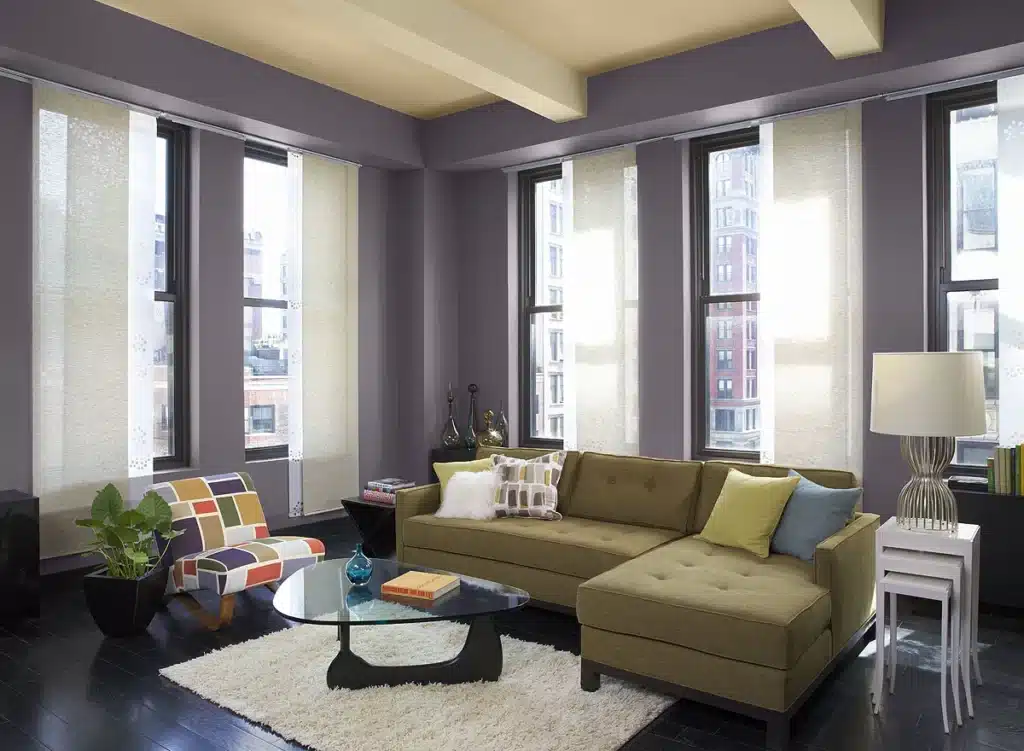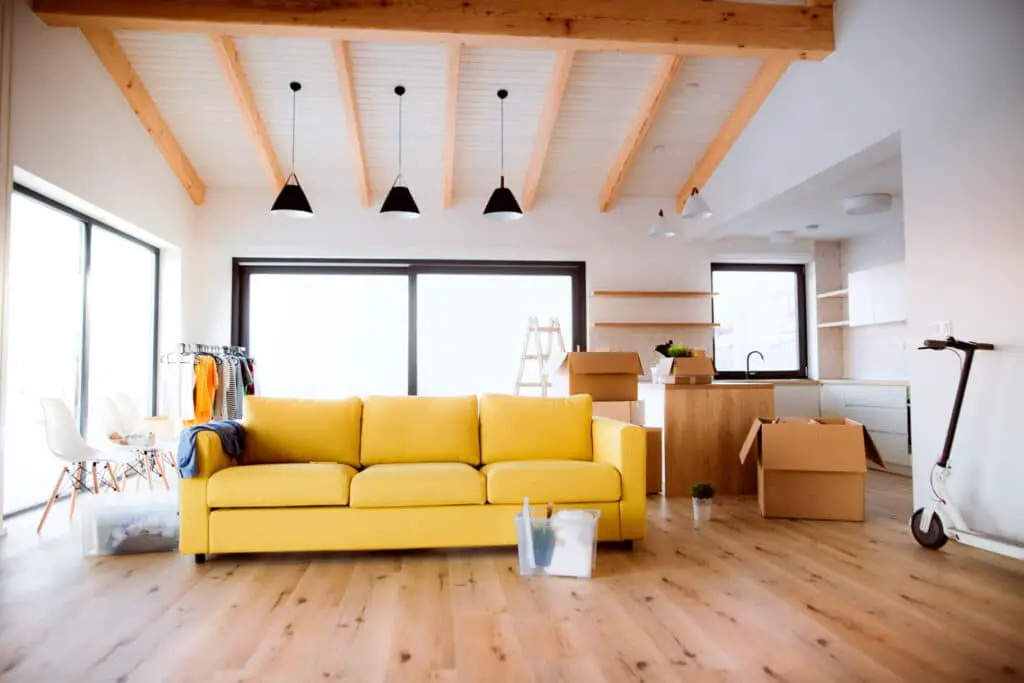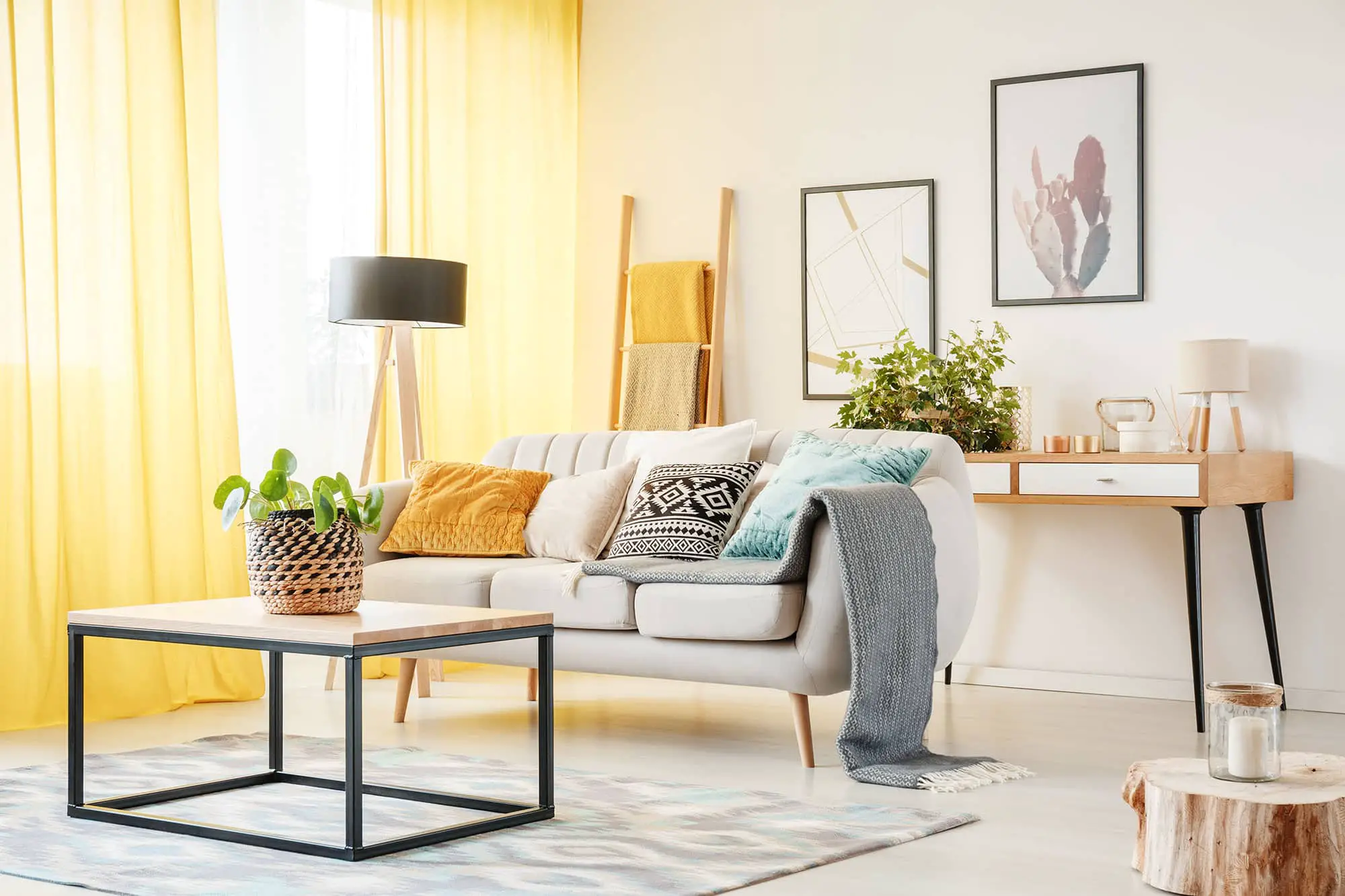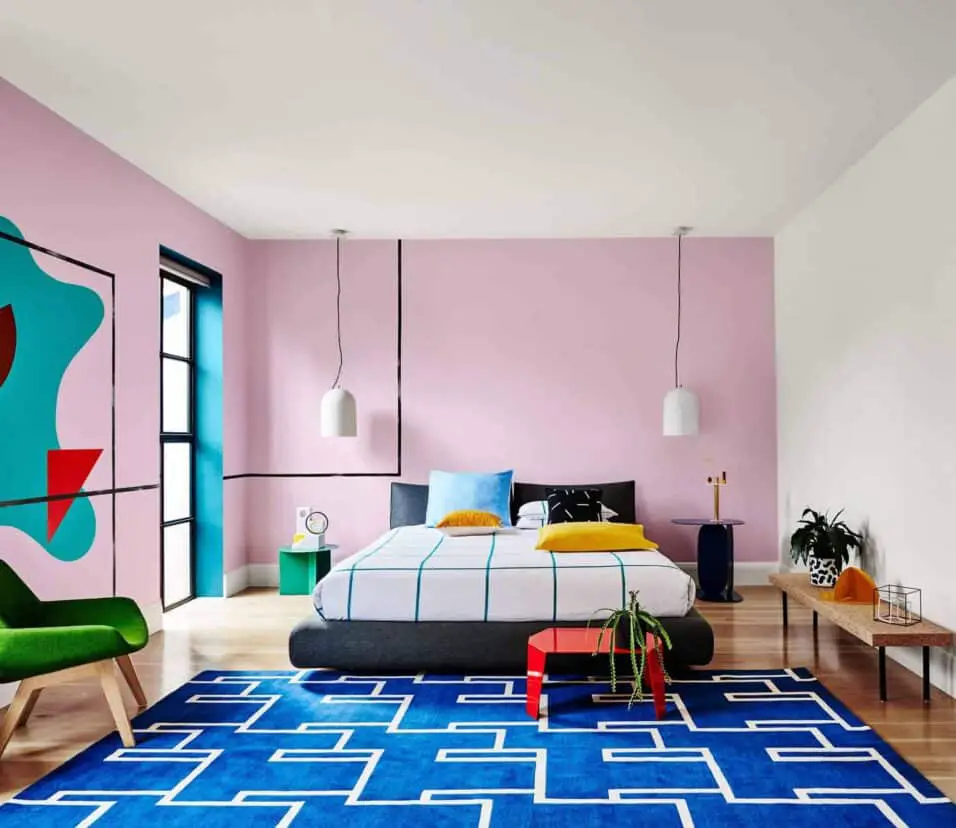What Colors Make A Room Look Bigger And Brighter
Introduction
What Colors Make A Room Look Bigger And Brighter: When it comes to creating an illusion of space and brightness in a room, the choice of colors plays a significant role. The strategic use of color can visually expand a room, making it appear larger, airier, and more inviting. By harnessing the power of color psychology and understanding how different hues interact with light, you can transform even the smallest of spaces into visually spacious and radiant environments.
We will delve into various color schemes, shades, and techniques that can enhance the perception of space, maximize natural light, and create an overall sense of openness. Whether you’re decorating a compact apartment, a cozy bedroom, or a cramped office, understanding the look bigger principles behind color selection can make a significant difference in the way a room feels and functions.
From cool and calming tones that visually recede to warm and vibrant hues that add depth, we will uncover the secrets of color manipulation to create the desired effect. Additionally, we’ll discuss the role of contrast, lighting, and other design elements that complement the chosen color palette, further enhancing the illusion of space and luminosity.

What color is best to make a room look bigger?
‘Lighter paint colors like off-whites, light neutrals, pales, and pastels give the illusion of larger, brighter rooms.
Soft pastel colors, including light blues, greens, and lavenders, can create a serene and expansive atmosphere. These hues have a similar effect to neutrals, as they visually recede and give the perception of depth. Pastels add a touch of color without overwhelming the space, making them an excellent choice for smaller rooms that require a gentle infusion of personality.
Cool colors, such as blues and greens, have a calming effect and can make a room feel more spacious. Light shades of these colors are particularly effective in expanding the visual boundaries of a room. Blue, in particular, is known for its ability to create the illusion of depth, mimicking the vastness of the sky or ocean. Incorporating cool tones in your color scheme can evoke a sense of tranquility and openness.
A monochromatic color scheme involves using different shades and tints of a single color. By sticking to one color family, you eliminate visual interruptions, creating a seamless flow that tricks the eye into perceiving a larger space. For example, using various shades of light gray or pale blue throughout the room creates a cohesive look and enhances the sense of continuity and openness.
While lighter colors dominate in making a room look bigger, incorporating bright accents can add depth and interest to the space. Introducing pops of vibrant colors through accessories, such as pillows, artwork, or rugs, can draw the eye and create focal points. These accents help break the monotony of a light color scheme while maintaining the overall sense of spaciousness.
Which Colour makes room brighter?
White is inherently bright and reflects light like no other. It might seem basic, but there are numerous hues with different undertones that’ll give you different results. A warmer white can feel welcoming, and something with blue or green undertones could appeal to your hope for something more refreshing.
Although not strictly colors, incorporating mirrors and metallic accents can significantly enhance the brightness of a room. Mirrors, especially when strategically placed opposite windows or light sources, reflect light and create the illusion of more space. Metallic finishes, such as silver, gold, or chrome, have reflective properties that amplify light, adding sparkle and brightness to the room.
While cool colors are known for their brightness, warm and sunny tones can also contribute to a well-lit room. Light yellows and soft oranges have a cheerful and invigorating effect, evoking the warmth and radiance of sunlight. These colors can create a cozy and welcoming atmosphere, enhancing the overall brightness of the space.
In addition to color choices, incorporating glossy and reflective surfaces can help brighten a room. High-gloss finishes on furniture, flooring, or decorative elements reflect light and create a sense of luminosity. Similarly, glass or mirrored surfaces can bounce light around the room, making it appear brighter and more spacious.
When aiming to make a room brighter, it’s important to consider other factors such as lighting, window treatments, and furniture placement. Maximizing natural light through the use of sheer curtains or blinds, strategically placing lighting fixtures, and arranging furniture to allow light to flow freely can all contribute to a brighter room.
What colours make a small bedroom look bigger?
Pastels work wonderfully in small rooms, as do whispery-light shades of gray. Try white mixed with one bright or mid-tone color, such as the blue and white shown here. For the most impact, stick with cool colors—shades of soft blue, green, and purple help enlarge a space, while the warmer hues have the opposite effect.
Soft pastel colors, such as light blues, greens, and lavenders, can work wonders in a small bedroom. These hues have a similar effect to neutrals, as they visually recede and give the impression of depth. Pastels add a touch of color without overwhelming the space, making them an excellent choice for creating a visually expanded and soothing environment.
Using a monochromatic color scheme can create a cohesive and visually expanded look in a small bedroom. Stick to variations of a single color by using different shades and tints. This eliminates visual interruptions and creates a seamless flow, tricking the eye into perceiving a larger space. Whether it’s different shades of light gray or pale blue, a monochromatic approach can enhance the sense of continuity and spaciousness.
Colours make a small bedroom
Cool colors, such as light blues, greens, and grays, have a calming effect and can make a small bedroom feel more spacious. These hues evoke a sense of tranquility and openness, contributing to a visually expanded atmosphere. Consider using light shades of these cool tones on the walls, bedding, and decor to create a serene and airy ambiance.
In a small bedroom, minimizing contrast can help create a sense of unity and make the space feel larger. Avoid using contrasting colors that divide the room visually. Instead, opt for a more harmonious color palette with subtle variations. This approach ensures a cohesive and uninterrupted flow throughout the room, enhancing the perception of size.
While color plays a crucial role, maximizing natural light is equally important in making a small bedroom appear bigger. Ensure that window treatments allow ample light to enter the room, making it feel bright and airy. Additionally, strategically placing mirrors can reflect both natural and artificial light, creating the illusion of more space and enhancing brightness.
What makes a room look big?
Yes, you know that mirrors make a space appear larger. (“It’s like doubling a room,” Curtis says.) But other reflective surfaces — high-gloss painted ceilings, lacquered furniture, shiny tile on a kitchen backsplash — have a similar effect, casting light and creating the illusion of volume.
Natural lighting plays a crucial role in making a room look big. Maximizing the amount of natural light entering the space can enhance the sense of openness and airiness. Keep windows uncovered or use sheer curtains to allow maximum light penetration. If privacy is a concern, consider using blinds or shades that can be easily adjusted to control the amount of light entering the room.
Mirrors are an excellent tool for making a room look big. Placing mirrors on walls opposite windows or light sources can reflect light and create the illusion of depth and additional space. Mirrors can also create visual continuity, as they reflect the room back to itself, making it feel more expansive.
Add reflective surfaces
A cluttered room can feel cramped and small. To make a room look big, declutter and organize your belongings. Keep surfaces clear and use storage solutions to minimize visual distractions. A clean and uncluttered space allows light to bounce off surfaces and gives the impression of a more open and spacious environment.
The arrangement of furniture can greatly impact the perceived size of a room. Avoid placing furniture in a way that obstructs the flow of the space or creates visual barriers. Instead, consider floating furniture away from walls and leaving negative space around pieces. This creates a sense of openness and makes the room appear larger.
Drawing the eye upward can create the illusion of height and make a room look big. Incorporate vertical elements such as floor-to-ceiling curtains, tall bookcases, or vertical artwork to create a sense of grandeur. This vertical emphasis adds visual interest and expands the perceived dimensions of the room.
Does gray make a room look bigger?
Gray can make a room look bigger. A light gray can be a great pick in place of white; it will reflect natural light, but it looks less architectural and cool than white, which you might prefer.
Gray is often considered a neutral color, and it can serve as an excellent base for a room’s color scheme. Its versatility allows it to complement a wide range of other colors and materials, creating a harmonious and balanced aesthetic. By using gray as a neutral backdrop, you can create a cohesive and uncluttered environment that contributes to the perception of a larger space.
To create depth and visual interest in a room, consider using different shades of gray to create contrast. For instance, pairing light gray walls with darker gray furniture or accessories can add dimension and make the room feel more expansive. The contrast between light and dark shades of gray creates a sense of depth, visually expanding the boundaries of the space.
Gray has a calming and soothing effect, making it a suitable choice for bedrooms or areas where relaxation is desired. A serene and tranquil atmosphere can contribute to a sense of spaciousness by eliminating visual clutter and promoting a feeling of openness. Consider using soft gray tones in these spaces to create a soothing and visually expansive environment.
Gray can be enhanced by incorporating texture and patterns into the room’s design. Textured gray wallpapers, patterned gray fabrics, or textured gray furniture can add visual interest without overwhelming the space. These elements create a sense of depth and complexity, enhancing the room’s overall aesthetic and making it feel larger.

What patterns make a room feel bigger?
Stripes can work wonders!
Thin stripes give the appearance of stretching, vertical stripes will make a room appear taller and horizontal stripes will make a room look wider. Consider applying striped wallpaper to not only create an illusion of more space but to create a simplistic feature wall.
Diagonal patterns, such as herringbone or chevron, can create a sense of movement and depth in a room. When used on flooring or in textiles, diagonal patterns can guide the eye along the lines, making the space feel larger. The diagonal lines create a visual flow that adds visual interest and expands the perceived dimensions of the room.
Geometric patterns, such as hexagons, triangles, or squares, can create a dynamic and visually engaging space. When used sparingly and strategically, geometric patterns can add depth and dimension to a room. Consider incorporating geometric patterns in rugs, artwork, or accent pillows to create focal points and give the illusion of a larger area.
patterns make a room
Patterns that feature mirrors or repetition can create an expansive and cohesive look in a room. Mirrored patterns, such as mirrored tiles or mirrored furniture, reflect light and create the illusion of additional space. Repeated patterns, such as wallpaper with a consistent motif, can visually expand the room by creating a sense of continuity and harmony.
In smaller rooms, using small-scale patterns can be beneficial. Large-scale patterns can overwhelm the space and make it feel cramped. Opt for smaller patterns, such as delicate florals or intricate designs, to maintain a sense of openness. These patterns can add visual interest without overpowering the room.
Tone-on-tone patterns involve using patterns in similar shades or colors as the background. This creates a subtle and sophisticated look that enhances the perception of space. By avoiding high contrast, the patterns blend into the background and create a harmonious and visually expanded environment.
What angle makes a room look bigger?
Wide angle lens
Use a wide angle lens
Again, obvious but a wide angle lens will let in more of the surrounding thus making it look bigger. Don’t take this too far and use a fish eye lens but be careful that your straight lines are still straight.
If you have a room with slanted ceilings or a vaulted ceiling, embrace this architectural feature to make the space feel bigger. Slanted ceilings create an interesting and unique visual effect that draws the eye upward. This upward movement gives the impression of increased height and verticality, expanding the perceived size of the room.
The way you position furniture in a room can greatly impact the perceived size. Avoid placing furniture directly against walls and consider angling it slightly. By creating angles with furniture arrangements, you add depth and visual interest to the room. Angled furniture placement can break up the straight lines of the walls and create a more spacious feel.
Illusion of a bigger room
Mirrors play a powerful role in creating the illusion of a bigger room. Placing mirrors strategically on walls or at angles can reflect light and create the perception of more space. Mirrors also have the ability to visually extend the room by bouncing the reflection, making it appear larger and more open.
Consider the sightlines within the room and how they contribute to the perception of size. Ensure that there are unobstructed views and visual continuity between different areas of the room. This can be achieved by avoiding tall furniture or partitions that block the line of sight. By maintaining open sightlines, you create a sense of spaciousness and flow.
The view outside a window can also impact the perceived size of a room. If possible, position furniture or create seating areas that take advantage of a pleasant natural view. This brings a sense of depth and expansiveness to the room, as the eyes are drawn beyond the confines of the space.
How can I make my room feel brighter and bigger?
21 Clever Tricks to Make Your Home Look Bigger and Brighter
- Clean the Windows. 1/22.
- Use Mirrors Strategically. 2/22.
- Rearrange Furniture. 3/22.
- Streamline Your Shelves. 4/22.
- Cut Back on Clutter. 5/22.
- Hang Sheer Window Treatments. 6/22.
- Cut Back Foliage. 7/22.
- Choose the Right Fabrics. 8/22.
Mirrors are a powerful tool for creating the illusion of a brighter and bigger room. Place mirrors strategically on walls opposite windows or light sources to reflect light and make the space feel larger. Consider using mirrored furniture or accessories to amplify the effect.
A cluttered room can feel smaller and darker. Decluttering and organizing your space is essential for creating a brighter and more open environment. Get rid of unnecessary items and find storage solutions to keep surfaces clear. This allows light to bounce off surfaces and gives the impression of a more spacious room.
Strategic furniture placement can greatly impact the perceived size of a room. Avoid blocking natural light sources and keep furniture away from pathways and doorways. Use furniture with exposed legs to create a sense of openness. Arranging furniture away from walls and creating conversation areas can also make the room feel more inviting and expansive.
In addition to natural light, consider incorporating various lighting sources to brighten up your room. Use a combination of overhead lighting, task lighting, and accent lighting to create layers of light. Choose light fixtures with warm or cool tones based on your preference and the desired ambiance. Well-placed lighting can visually expand the room and create a brighter atmosphere.
Make use of vertical space to create a sense of height and maximize storage. Install shelves or wall-mounted storage units to keep the floor clear and open up the room. Vertical elements draw the eye upward, making the room feel taller and more spacious.

Conclusion
Cool and calming tones, such as light blues and soft greens, have the ability to visually recede and create a sense of depth, making a room appear larger. These colors are particularly effective when used on walls and larger surfaces. Additionally, neutral shades like whites, creams, and grays contribute to the perception of openness, while reflecting light and creating a brighter ambiance.
Contrast, another essential aspect of color selection, can be employed to add depth and dimension to a room. Remember to experiment, trust your intuition, and embrace the transformative power of colors to design living spaces that inspire and uplift.
By incorporating light and dark elements, such as pairing light walls with darker furniture or using bold accents against a neutral backdrop, you create a visually dynamic space that feels expansive and vibrant. Natural and artificial lighting also plays a crucial role in maximizing the impact of color. Optimizing the use of natural light through the strategic placement of mirrors, sheer curtains, and light-colored window treatments can amplify the bigger brighter of a room. Similarly, well-placed artificial lighting, including overhead fixtures, task lighting, and accent lights, can accentuate the chosen color scheme and create a sense of spaciousness.
Lastly, attention to detail in terms of furniture arrangement, decluttering, and selecting the right textures and finishes can further enhance the illusion of a larger and brighter room. Light-colored furniture and furnishings contribute to a sense of airiness, while maintaining an uncluttered space allows light to bounce off surfaces freely. By understanding the principles of color psychology, utilizing appropriate contrast, optimizing lighting, and paying attention to the overall design elements, you can create a room that feels expansive and radiates with brightness.




